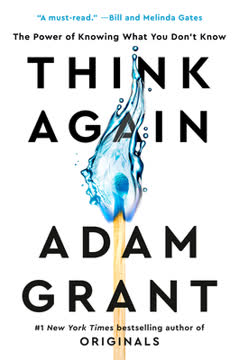Key Takeaways
1. Creativity is essential for effective problem-solving and can be cultivated
"The greatest of these is creativity."
Creativity is learnable. While often suppressed during the process of growing up, creativity can be reacquired and developed. It involves the ability to identify and remove self-imposed constraints, enabling innovative solutions to complex problems.
Techniques to foster creativity:
- Engage in idealized design exercises
- Participate in interdisciplinary problem-solving teams
- Question assumptions and "obvious" facts
- Seek diverse perspectives and unconventional ideas
By cultivating creativity, managers can lead organizations to quantum leaps forward, rather than merely presiding over gradual evolution. Creative problem-solving allows for the generation of novel solutions that can significantly improve organizational performance and competitiveness.
2. Self-imposed constraints often limit problem-solving capabilities
"A puzzle is a problem that one cannot solve because of a self-imposed constraint."
Identifying constraints is key. Many limitations in problem-solving are unconsciously self-imposed. These constraints often stem from our education, experience, and preconceived notions about what is possible or acceptable.
Overcoming self-imposed constraints:
- Actively question assumptions about the problem
- Consider perspectives from different disciplines or backgrounds
- Explore unconventional or seemingly "impossible" solutions
- Use techniques like reference projections to reveal hidden possibilities
By recognizing and challenging these self-imposed constraints, problem-solvers can unlock a wider range of potential solutions. This approach often leads to more creative and effective outcomes, as it allows for the consideration of ideas that might otherwise be dismissed prematurely.
3. Idealized design stimulates innovative thinking and organizational improvement
"An idealized design is not utopian precisely because it is capable of being improved."
Reimagine from scratch. Idealized design involves creating a vision of the best possible system or solution, unconstrained by current limitations. This process encourages participants to think beyond incremental improvements and consider radical redesigns.
Benefits of idealized design:
- Challenges status quo thinking
- Reveals hidden opportunities and potential innovations
- Facilitates consensus-building around shared objectives
- Provides a clear target for long-term planning and development
By engaging in idealized design, organizations can break free from the limitations of their current structures and processes. This approach stimulates creative thinking and helps identify transformative changes that can significantly improve performance and adaptability.
4. Understanding stakeholder objectives is crucial for resolving conflicts
"Irrationality is usually in the mind of the beholder, not in the mind of the beheld."
Empathy drives resolution. Effective conflict resolution requires a deep understanding of all stakeholders' objectives, motivations, and constraints. What may appear irrational from one perspective often has a logical basis when viewed from another's standpoint.
Strategies for understanding stakeholder objectives:
- Conduct thorough stakeholder analyses
- Engage in direct dialogue and active listening
- Use participative problem-solving approaches
- Seek to identify underlying needs and interests, not just stated positions
By developing a comprehensive understanding of stakeholder objectives, problem-solvers can identify creative solutions that address the core needs of all parties involved. This approach often leads to more sustainable and mutually beneficial resolutions to conflicts.
5. Uncontrolled variables can be transformed into controllable elements
"One uncontrolled variable can often be used to cancel the harmful effect of another."
Expand the system boundaries. Many seemingly uncontrollable variables can be influenced or managed by expanding the scope of the problem and considering broader systemic interactions. This approach often reveals new opportunities for control and improvement.
Techniques for managing uncontrolled variables:
- Analyze interactions between variables to identify leverage points
- Consider vertical or horizontal integration strategies
- Use incentives to influence external stakeholder behavior
- Employ systems thinking to reveal hidden connections and influences
By creatively approaching uncontrolled variables, problem-solvers can often find ways to exert influence or control over previously intractable elements of a system. This can lead to more comprehensive and effective solutions to complex problems.
6. Causal relationships, not mere associations, should guide decision-making
"The less we understand something, the more variables we require to explain it."
Correlation is not causation. Effective problem-solving and decision-making require a deep understanding of causal relationships between variables. Relying on mere associations or correlations can lead to misguided interventions and ineffective solutions.
Approaches to establishing causality:
- Design and conduct controlled experiments
- Use statistical techniques that account for confounding variables
- Develop and test causal models or theories
- Seek out natural experiments or quasi-experimental situations
By focusing on causal relationships, decision-makers can develop more accurate models of system behavior and design more effective interventions. This approach helps avoid the pitfalls of spurious correlations and leads to more robust and reliable solutions.
7. Multidimensional organizational structures enhance flexibility and responsiveness
"Every gain of control over others is a potential loss of control over oneself."
Rethink organizational design. Traditional hierarchical structures often struggle to adapt to rapidly changing environments. Multidimensional organizational designs offer greater flexibility and responsiveness by breaking down silos and fostering cross-functional collaboration.
Key features of multidimensional organizations:
- Matrix-like structures with multiple reporting relationships
- Program-based units focused on specific outputs or objectives
- Internal markets for services and resources
- Flexible allocation of personnel and resources based on changing needs
By adopting multidimensional structures, organizations can become more adaptable and better equipped to handle complex, rapidly evolving challenges. This approach enhances coordination across functions and allows for more efficient allocation of resources.
8. Circular organizations balance hierarchy with democratic participation
"No individual may be subjected to the control of another who is not subject to control by those over whom he has some control."
Democratize without sacrificing efficiency. Circular organizational designs reconcile the need for hierarchical coordination with democratic participation. This approach ensures that authority is balanced with accountability at all levels of the organization.
Elements of circular organizations:
- Boards at each level that include subordinates, superiors, and peers
- Participative policy-making and performance evaluation
- Clear separation between policy-setting and operational management
- Mechanisms for bottom-up influence and feedback
By implementing circular designs, organizations can maintain the efficiency benefits of hierarchy while fostering greater engagement, accountability, and adaptability. This structure helps prevent the development of autocratic management styles and promotes more responsive decision-making.
9. Advertising effectiveness requires understanding consumer behavior and psychology
"Sugar is sweet but not a source of heat."
Dig deeper into motivations. Effective advertising and marketing strategies must be grounded in a nuanced understanding of consumer psychology and behavior. Surface-level assumptions about consumer motivations often lead to misguided and ineffective campaigns.
Approaches to understanding consumer behavior:
- Conduct in-depth qualitative research to uncover underlying motivations
- Develop and test psychological models of consumer decision-making
- Use experimental designs to validate advertising effectiveness
- Segment markets based on psychological profiles rather than demographics alone
By investing in a deeper understanding of consumer psychology, organizations can develop more targeted and effective marketing strategies. This approach helps avoid wasteful advertising expenditures and leads to stronger brand-consumer relationships.
10. Experimental research is vital for validating theories and improving strategies
"A little bit of understanding can go a long way, but one may have to go a long way to get a little bit of understanding."
Test, learn, and adapt. Rigorous experimental research is essential for validating theories and improving organizational strategies. This approach helps distinguish between effective and ineffective practices and guides continuous improvement efforts.
Key principles of experimental research in organizations:
- Design controlled experiments to test specific hypotheses
- Use randomization and control groups to isolate causal effects
- Implement iterative testing cycles to refine strategies over time
- Be open to unexpected results and use them to guide further inquiry
By embracing experimental research methods, organizations can make more informed decisions and develop more effective strategies. This approach helps reduce reliance on untested assumptions and leads to continuous improvement in organizational performance.
Last updated:
FAQ
What's The Art of Problem Solving about?
- Creative Problem Solving: The book emphasizes the need for innovative approaches to problem solving, moving beyond traditional, rigid frameworks.
- Philosophy and Science Integration: Ackoff combines insights from various disciplines to enhance problem-solving capabilities through creativity.
- Real-World Applications: It offers practical examples and fables to illustrate key concepts, making problem solving more enjoyable and effective.
Why should I read The Art of Problem Solving?
- Enhance Creativity: The book helps unlock creative potential, essential for personal and professional growth.
- Practical Insights: Filled with real-life examples and fables, it makes complex ideas accessible and relatable.
- Broaden Perspective: Encourages questioning self-imposed constraints, fostering openness to new possibilities.
What are the key takeaways of The Art of Problem Solving?
- Creativity is Essential: Ackoff stresses creativity as crucial for effective management and problem solving.
- Identify Constraints: Recognizing and challenging self-imposed constraints can lead to new solution avenues.
- Holistic Approach: A comprehensive view of problems, considering all variables and interconnections, leads to effective solutions.
What are the best quotes from The Art of Problem Solving and what do they mean?
- "We must continually learn to unlearn much that we have learned.": Highlights adaptability and openness to new ideas.
- "A puzzle is a problem that we usually cannot solve because we make an incorrect assumption that precludes a solution.": Emphasizes questioning assumptions for breakthroughs.
- "The creativity of children is suppressed at home and at school.": Critiques societal structures that stifle creativity, urging for its nurturing.
How does Ackoff define a "problem" in The Art of Problem Solving?
- Real Problems vs. Puzzles: Real problems have significant implications, unlike trivial puzzles.
- Components of a Problem: Includes decision makers, variables, constraints, and outcomes.
- Choice and Doubt: Problems arise from doubt about action effectiveness, resolved through informed decision-making.
What methods does Ackoff suggest for enhancing problem-solving creativity?
- Identify Constraints: Recognizing and removing self-imposed constraints opens new solution possibilities.
- Use of Fables: Fables illustrate creative problem-solving principles, making complex ideas relatable.
- Idealized Design: Envisioning an ideal state and working backward encourages innovative thinking.
What is Ackoff's view on creativity in management?
- Creativity as Core Competency: Essential for managers to lead organizations effectively with innovative solutions.
- Education's Role: Critiques educational systems for not nurturing creativity, focusing on competence instead.
- Making Breaks: Creative managers proactively create opportunities, essential for significant advancements.
How does The Art of Problem Solving address the role of uncontrolled variables?
- Understanding the Environment: Recognizing uncontrolled variables is crucial for effective solutions.
- Interconnectedness of Variables: Encourages collaboration, as what is uncontrollable for one may be controllable for another.
- Enlarging the System: Expanding the system can make previously uncontrollable variables manageable.
What is the significance of "Ackoff's Fables" in The Art of Problem Solving?
- Illustrative Learning: Fables provide engaging narratives that illustrate key problem-solving concepts.
- Diverse Scenarios: Each fable presents unique scenarios highlighting different problem-solving aspects.
- Moral Lessons: Concludes with morals that encapsulate lessons, encouraging reflection and application.
What is Ackoff's view on causality in problem-solving?
- Causality is Key: Understanding causal relationships is essential for effective problem-solving.
- Weak vs. Strong Causality: Differentiates between testable strong causality and common weak causality in real-world problems.
- Association vs. Causation: Stresses the importance of distinguishing between correlation and causation for informed decisions.
How does Ackoff suggest we approach problem-solving?
- Research-Driven Approach: Emphasizes gathering data and insights before making decisions.
- Iterative Process: Problem-solving requires continuous monitoring and adjustment.
- Creative Thinking: Encourages exploring unconventional solutions for effective outcomes.
How can one apply the concepts from The Art of Problem Solving in real life?
- Critical Evaluation: Evaluate assumptions and variable relationships in problem-solving efforts.
- Research and Data Gathering: Implement a research-driven approach for enhanced decision-making.
- Iterative Improvement: Embrace an iterative process to adapt and improve solutions continuously.
Review Summary
The Art of Problem Solving is generally well-received, with readers praising Ackoff's fresh and interesting writing style. The book is divided into two parts, with the first part being more universally appealing and exploring systems thinking and problem-solving concepts. The second part, while valuable for professionals, may feel outdated to some readers. Many appreciate Ackoff's philosophical approach and creative ideas, though some found the book could be more concise. Overall, readers find the book's principles still relevant despite its age.
Similar Books










Download PDF
Download EPUB
.epub digital book format is ideal for reading ebooks on phones, tablets, and e-readers.




